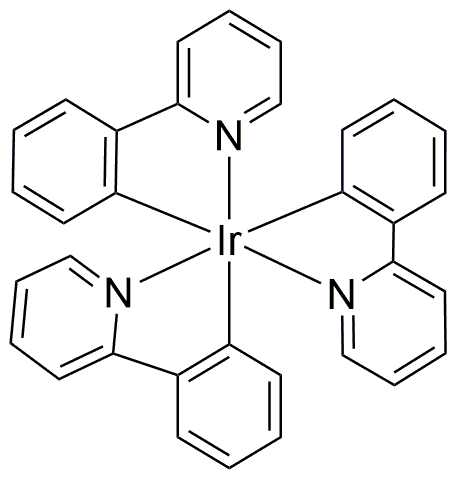Tris(2-phenylpyridinato)iridium(III) is widely utilized in research focused on:
- Organic Light Emitting Diodes (OLEDs): This compound serves as an efficient phosphorescent emitter in OLEDs, enhancing light output and energy efficiency, making it ideal for display technologies.
- Chemical Sensors: Its unique luminescent properties allow for the development of sensitive chemical sensors, which can detect specific analytes in environmental monitoring and safety applications.
- Photodynamic Therapy: In the medical field, it shows promise in photodynamic therapy for cancer treatment, where its light-activated properties can selectively target and destroy cancer cells.
- Solar Cells: The compound is being explored for use in next-generation solar cells, where it can improve light absorption and conversion efficiency, contributing to renewable energy solutions.
- Catalysis: It acts as a catalyst in various organic reactions, offering advantages in reaction rates and selectivity, which is beneficial for pharmaceutical synthesis and other chemical processes.
General Information
Properties
Safety and Regulations
Applications
Tris(2-phenylpyridinato)iridium(III) is widely utilized in research focused on:
- Organic Light Emitting Diodes (OLEDs): This compound serves as an efficient phosphorescent emitter in OLEDs, enhancing light output and energy efficiency, making it ideal for display technologies.
- Chemical Sensors: Its unique luminescent properties allow for the development of sensitive chemical sensors, which can detect specific analytes in environmental monitoring and safety applications.
- Photodynamic Therapy: In the medical field, it shows promise in photodynamic therapy for cancer treatment, where its light-activated properties can selectively target and destroy cancer cells.
- Solar Cells: The compound is being explored for use in next-generation solar cells, where it can improve light absorption and conversion efficiency, contributing to renewable energy solutions.
- Catalysis: It acts as a catalyst in various organic reactions, offering advantages in reaction rates and selectivity, which is beneficial for pharmaceutical synthesis and other chemical processes.
Documents
Safety Data Sheets (SDS)
The SDS provides comprehensive safety information on handling, storage, and disposal of the product.
Product Specification (PS)
The PS provides a comprehensive breakdown of the product’s properties, including chemical composition, physical state, purity, and storage requirements. It also details acceptable quality ranges and the product's intended applications.
Certificates of Analysis (COA)
Search for Certificates of Analysis (COA) by entering the products Lot Number. Lot and Batch Numbers can be found on a product’s label following the words ‘Lot’ or ‘Batch’.
*Catalog Number
*Lot Number
Certificates Of Origin (COO)
This COO confirms the country where the product was manufactured, and also details the materials and components used in it and whether it is derived from natural, synthetic, or other specific sources. This certificate may be required for customs, trade, and regulatory compliance.
*Catalog Number
*Lot Number
Safety Data Sheets (SDS)
The SDS provides comprehensive safety information on handling, storage, and disposal of the product.
DownloadProduct Specification (PS)
The PS provides a comprehensive breakdown of the product’s properties, including chemical composition, physical state, purity, and storage requirements. It also details acceptable quality ranges and the product's intended applications.
DownloadCertificates of Analysis (COA)
Search for Certificates of Analysis (COA) by entering the products Lot Number. Lot and Batch Numbers can be found on a product’s label following the words ‘Lot’ or ‘Batch’.
*Catalog Number
*Lot Number
Certificates Of Origin (COO)
This COO confirms the country where the product was manufactured, and also details the materials and components used in it and whether it is derived from natural, synthetic, or other specific sources. This certificate may be required for customs, trade, and regulatory compliance.


